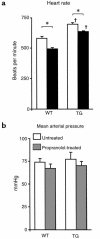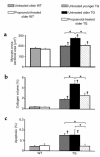Beta-adrenergic receptor blockade arrests myocyte damage and preserves cardiac function in the transgenic G(salpha) mouse
- PMID: 10487769
- PMCID: PMC408547
- DOI: 10.1172/JCI7418
Beta-adrenergic receptor blockade arrests myocyte damage and preserves cardiac function in the transgenic G(salpha) mouse
Abstract
Transgenic (TG) mice with cardiac G(salpha) overexpression exhibit enhanced inotropic and chronotropic responses to sympathetic stimulation, but develop cardiomyopathy with age. We tested the hypothesis that cardiomyopathy in TG mice with G(salpha) overexpression could be averted with chronic beta-adrenergic receptor (beta-AR) blockade. TG mice and age-matched wild-type littermates were treated with the beta-AR blocker propranolol for 6-7 months, starting at a time when the cardiomyopathy was developing but was not yet severe enough to induce significant cardiac depression (9.5 months of age), and ending at a time when cardiac depression and cardiomyopathy would have been clearly manifest (16 months of age). Propranolol treatment, which can induce cardiac depression in the normal heart, actually prevented cardiac dilation and the depressed left ventricular function characteristic of older TG mice, and abolished premature mortality. Propranolol also prevented the increase in myocyte cross-sectional area and myocardial fibrosis. Myocyte apoptosis, already apparent in 9-month-old TG mice, was actually eliminated by chronic propranolol. This study indicates that chronic sympathetic stimulation over an extended period is deleterious and results in cardiomyopathy. Conversely, beta-AR blockade is salutary in this situation and can prevent the development of cardiomyopathy.
Figures





Similar articles
-
Overexpression of myocardial Gsalpha prevents full expression of catecholamine desensitization despite increased beta-adrenergic receptor kinase.J Clin Invest. 1998 May 1;101(9):1916-22. doi: 10.1172/JCI1530. J Clin Invest. 1998. PMID: 9576756 Free PMC article.
-
Common genomic response in different mouse models of beta-adrenergic-induced cardiomyopathy.Circulation. 2003 Dec 9;108(23):2926-33. doi: 10.1161/01.CIR.0000101922.18151.7B. Epub 2003 Nov 17. Circulation. 2003. PMID: 14623810
-
Disruption of type 5 adenylyl cyclase prevents β-adrenergic receptor cardiomyopathy: a novel approach to β-adrenergic receptor blockade.Am J Physiol Heart Circ Physiol. 2014 Nov 15;307(10):H1521-8. doi: 10.1152/ajpheart.00491.2014. Epub 2014 Sep 5. Am J Physiol Heart Circ Physiol. 2014. PMID: 25193472 Free PMC article.
-
Beta-adrenergic receptor-G protein-adenylyl cyclase signal transduction in the failing heart.Am J Cardiol. 1999 Jun 17;83(12A):80H-85H. doi: 10.1016/s0002-9149(99)00266-0. Am J Cardiol. 1999. PMID: 10750593 Review.
-
The beta-adrenergic receptors.Herz. 2002 Nov;27(7):683-90. doi: 10.1007/s00059-002-2434-z. Herz. 2002. PMID: 12439640 Review.
Cited by
-
Cardiac beta ARK1 inhibition prolongs survival and augments beta blocker therapy in a mouse model of severe heart failure.Proc Natl Acad Sci U S A. 2001 May 8;98(10):5809-14. doi: 10.1073/pnas.091102398. Epub 2001 May 1. Proc Natl Acad Sci U S A. 2001. PMID: 11331748 Free PMC article.
-
Beta-adrenergic stimulation and myocardial function in the failing heart.Heart Fail Rev. 2009 Dec;14(4):225-41. doi: 10.1007/s10741-008-9132-8. Heart Fail Rev. 2009. PMID: 19110970 Review.
-
Effects of anesthesia on conventional and speckle tracking echocardiographic parameters in a mouse model of pressure overload.Exp Ther Med. 2015 May;9(5):1679-1687. doi: 10.3892/etm.2015.2331. Epub 2015 Mar 3. Exp Ther Med. 2015. PMID: 26136877 Free PMC article.
-
Vidarabine, an anti-herpes agent, improves Porphyromonas gingivalis lipopolysaccharide-induced cardiac dysfunction in mice.J Physiol Sci. 2023 Aug 9;73(1):18. doi: 10.1186/s12576-023-00873-5. J Physiol Sci. 2023. PMID: 37558983 Free PMC article.
-
Regulator of G Protein Signaling 6 Protects the Heart from Ischemic Injury.J Pharmacol Exp Ther. 2017 Mar;360(3):409-416. doi: 10.1124/jpet.116.238345. Epub 2016 Dec 29. J Pharmacol Exp Ther. 2017. PMID: 28035008 Free PMC article.
References
-
- Hittinger L, et al. Hemodynamic mechanisms responsible for reduced subendocardial coronary reserve in dogs with severe left ventricular hypertrophy. Circulation. 1995;92:978–986. - PubMed
-
- Koch WJ, et al. Cardiac function in mice overexpressing the β-adrenergic receptor kinase or a βARK inhibitor. Science. 1995;268:1350–1353. - PubMed
-
- Milano CA, et al. Enhanced myocardial function in transgenic mice overexpressing the β2-adrenergic receptor. Science. 1994;264:582–586. - PubMed
MeSH terms
Substances
LinkOut - more resources
Full Text Sources
Molecular Biology Databases
Research Materials
Miscellaneous

